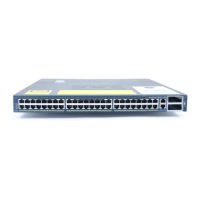124 Cisco LAN Switching Configuration Handbook
Finally, Catalyst A1 will have the port cost adjusted for ports 1/1 and 1/2 for the two
VLANs. Recall that the default port cost is shown as 19 in the diagram. We set the new
costs to 1000 on the undesirable paths so that those ports will be blocking. For example,
VLAN 101 on port 1/1 will be blocked because it has a higher port cost of 1000:
(global) interface fastethernet 1/1
(interface) spanning-tree vlan 101 cost 1000
(global) interface fastethernet 1/2
(interface) spanning-tree vlan 100 cost 1000
7-3: STP Convergence Tuning
■ STP bases its operation on several timers. Usually, the default timer values are used
for proper STP behavior. The defaults are based on a network diameter of seven
switches but can be adjusted for faster convergence times.
■ The Hello Timer triggers periodic hello messages to neighboring switches.
■ The Forward Delay timer specifies the time a port stays in each of the listening
and learning states.
■ The MaxAge timer specifies the lifetime of a stored BPDU received on a desig-
nated port. After the timer expires, other ports can become designated ports.
■ BPDUs are expected at regular intervals. If they are delayed beyond the lapse of an
STP timer, topology changes can be triggered in error. This condition can be detect-
ed with the BPDU skewing feature.
■ STP PortFast allows ports that connect to hosts or nonbridging network devices to
enter the forwarding mode immediately when the link is established. This bypasses
the normal STP port states for faster startup but allows the potential for bridging
loops to form.
■ STP UplinkFast is used only on leaf-node switches (the ends of the ST branches),
usually located in the access layer. The switch keeps track of all potential paths to
the root, which are in the blocking state.
■ When the root port fails, an alternate port is brought into the forwarding state
without the normal STP port state progression and delays.
■ When UplinkFast is enabled, the bridge priority is raised to 49152, making it
unlikely to become the root bridge. All switch ports have their port costs
increased by 3000 so that they won’t be chosen as root ports.
■ When an alternate root port comes up, the switch updates upstream switches
with the new location of downstream devices. Dummy multicasts are sent to des-
tination 01-00-0C-CD-CD-CD that contains the MAC addresses of stations in the
bridging table.
■ STP BackboneFast causes switches in the network core to actively look for alternate
paths to the root bridge in case of an indirect failure.

